Magasin des Modes, 7e Cahier, Plate I
 |
| January 20, 1787 |
So great is the quantity of redingotes, also called Franco-Anglomane gowns, that we've given, but it's necessary to do so again. Our Ladies have hardly any other dress. One will agree that at least we have varied the forms and the taste of all those that have been shown.
That which the Woman shown in PLATE I wears, very different from the others, is made and cut like chemise gowns. Like them, it is passed over the head or stepped into.
This redingote is of scarlet wool; it is fastened in front with large white buttons.
Its sleeves are slit on top à la Marinière, and along on the sides, where four little white buttons are sewn. We could say that this form of redingote is particularly designed for going about in a cabriolet, for we have seen Ladies getting into or out of cabriolets in it.
The Woman has a simple, puffed kerchief on her neck, with the ends falling like a man's jabot. She holds a rose in her right hand, and a cane in her left. On her feet are yellow Chinese sabots.
On her head, a black felt hat, girded with a scarlet ribbon, forming a large bow in the back and another in front. In the one in front is placed the image of a comet, painted blue.
In her ears, gold earring à la Plaquette.
Her tapet is frizzed all over.* Two large curls fall from it, on either side of her chest. Her hair is pulled up in back in a flat chignon.
With scarlet redingotes, blue, yellow, and grey felt hats are very frequently worn. These hats are trimmed with wide ribbons cinching the crowns, or three bands of fox-fur, or another animal, spaced apart on the crowns. Very often women don't wear hats at all, their heads dressed en cheveaux.
* The tapet is the shorter hair on the upper part of the head.



Comments
Post a Comment